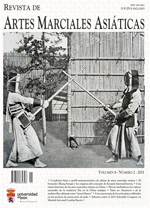Resumo do workshop "Organizar, Administrar e Regular as Artes marciais", durante a 21.ª conferência da EASM
DOI:
https://doi.org/10.18002/rama.v8i2.987Palavras-chave:
Artes marciais, desportos de combate, investigação científica, eventos científicos, congressos, EASMResumo
O presente texto resume o workshop “Organizar, Administrar e Regular as Artes Marciais”, organizado durante a 21.ª conferência da EASM, celebrada em Istambul (Turquia), no dia 12 de setembro de 2013. Esta foi a primeira conferência centrada nos aspetos políticos e organizativos das artes marciais (de pleno contacto físico). Durante este encontro internacional quatro científicos descreveram, em profundidade, a história recente e a atual situação da organização e regulação das artes marciais no seu País (i.e., França, Flandres - Bélgica, Itália e Holanda). O congresso foi um evento único, uma excelente oportunidade para obter uma melhor compreensão da situação específica da regulação das artes marciais em alguns países europeus e para intercâmbio dos resultados das investigações atuais sobre o tema. A realização de mais investigações poderia ajudar a compreender melhor como tratar os problemas associados à governança, regulação e gestão das artes marciais no contexto europeu.Downloads
Métricas alternativas
Referências
American Academy of Paediatrics (2011). Boxing participation by children and adolescents. Pediatrics, 128(3), 617‐23.
Dortants, M., & van Bottenburg, M. (2013). Aanzien en overleven in een sport vol passie ‐ over regulering van full contact‐vechtsporten [Respect and survive in a sport full of passion ‐ regulation of full‐contact martial arts]. Nieuwegein: Arko Sports Media.
Endresen, I.M. & Olweus, D. (2005). Participation in power sports and antisocial involvement inpreadolescent and adolescent boys. Journal of Child Psychology and Psychiatry, 46(5), 468‐78.
Fulton, J. (2011). ‘What’s your worth?’ – The development of capital in British boxing. European Journal for Sport and Society, 8(3), 192‐218.
Gauthier, J. (2009). Ethical and social issues in combat sports: should combat sports be banned? In R. Kordi, N. Maffulli, R.Wroble, & A.Wallace (Eds.). Combat Sports Medicine (pp. 151‐72). Springer: London.
Koppenjan & Klijn, 2004. Managing uncertainties in networks. A network approach to problema solving and decision making. Abington, Oxon: Routledge.
Pearn, J. (1998). Boxing, youth and children. Journal of Paediatrics and Child Health, 34, 311‐3. Reynes, E., & Lorant, J. (2002). Effect of traditional judo training on aggressiveness among young boys. Perceptual and Motor Skills, 94(1), 21‐5.
Van Bottenburg, M. & Heilbron, J. (1996). De verharding van het wedstrijdvechten (The hardening of competitive fighting). Amsterdam: Diopter.
Vertonghen, J., & Theeboom, M. (2013). How to obtain more insight into the true Nature of outcomes of youth martial arts Practice? Journal of Children’s Services, 8(4), 244‐253.
Wargo, M., Spirrison, C., Thorne, M., & Henley, T. (2007). Personality characteristics of martial artists. Social Behavior and Personality, 35(3), 399‐408.
World Medical Association (2005). WMA statement on boxing. Available at: www.wma.net/en/30publications/10policies/b6/index.html.
Downloads
Publicado
Como Citar
Edição
Secção
Licença
Direitos de Autor (c) 2014 Jikkemien Vertonghen, Marianne Dortants

Este trabalho encontra-se publicado com a Licença Internacional Creative Commons Atribuição-NãoComercial-CompartilhaIgual 4.0.
Os autores que publicam nesta Revista estão de acordo com os seguintes termos:
- Os autores cedem, de forma exclusiva, os direitos de exploração (reprodução, distribuição, comunicação pública, transformação) à Universidade de Léon, podendo estabelecer, em separado, acordos adicionais para a distribuição não exclusiva da versão do artigo publicado na Revista (por exemplo: alojar no repertório institucional ou publicá-lo num livro), com o reconhecimento da publicação inicial nesta Revista.
- O trabalho encontra-se na Creative Commons Attribution-Non Commercial-Share Alike 4.0 International License. Pode-se consultar aqui o resumo e o texto legal da licença.
- Permite-se, e sugere-se, que os autores difundam electronicamente as versões pré-impressão (versão antes de ser avaliada) e pós-impressão (versão avaliada e aceite para publicação das suas obras antes da sua publicação), favorecendo a sua circulação e difusão, e com ela o possível aumento da sua citação e alcance pela comunidade académica.











